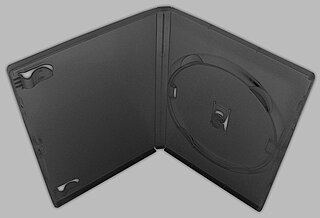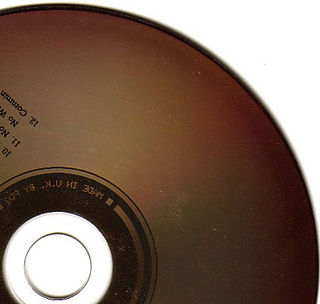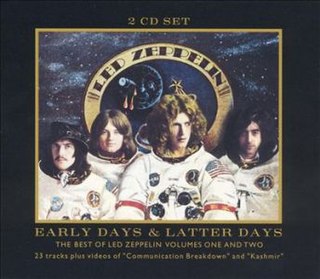Related Research Articles

The compact disc (CD) is a digital optical disc data storage format that was co-developed by Philips and Sony to store and play digital audio recordings. It uses the Compact Disc Digital Audio format which typically provides 74 minutes of audio on a disc. In later years, the compact disc was adapted for non-audio computer data storage purposes as CD-ROM and its derivatives. First released in Japan in October 1982, the CD was the second optical disc technology to be invented, after the much larger LaserDisc (LD). By 2007, 200 billion CDs had been sold worldwide.

An optical disc is a flat, usually disc-shaped object that stores information in the form of physical variations on its surface that can be read with the aid of a beam of light. Optical discs can be reflective, where the light source and detector are on the same side of the disc, or transmissive, where light shines through the disc to be detected on the other side.

Video CD is a home video format and the first format for distributing films on standard 120 mm (4.7 in) optical discs. The format was widely adopted in Southeast Asia, South Asia, East Asia, Central Asia and West Asia, superseding the VHS and Betamax systems in the regions until DVD-Video finally became affordable in the first decade of the 21st century.

Optical disc packaging is the packaging that accompanies CDs, DVDs, and other formats of optical discs. Most packaging is rigid or semi-rigid and designed to protect the media from scratches and other types of exposure damage.

A longbox is a form of exterior paperboard packaging for musical compact discs in widespread use in the 1980s and early 1990s in North America.
Video game packaging refers to the physical storage of the contents of a PC or console game, both for safekeeping and shop display. In the past, a number of materials and packaging designs were used, mostly paperboard or plastic. Today, most physical game releases are shipped in (CD) jewel cases or (DVD) keep cases, with little differences between them.
Mini CDs, or pocket CDs, are CDs with a smaller diameter and one-third the storage capacity of a standard 120 mm disc.

An album cover is the front packaging art of a commercially released studio album or other audio recordings. The term can refer to:

A CD single is a music single in the form of a compact disc (CD). Originally the CD single standard was an 8 cm (3-inch) "mini CD" (CD3); later on the term referred to any single recorded onto a CD of any size, particularly the 12 cm (5-inch) "full-size" disc (CD5). From a technical viewpoint, a CD single is identical to any other audio CD. The format started gaining popularity in the early 1990s, but quickly declined in the early and mid 2000s, in favor of digital downloaded singles and CD albums.

Optical storage refers to a class of data storage systems that use light to read or write data to an underlying optical media. Although a number of optical formats have been used over time, the most common examples are optical disks like the compact disc (CD) and DVD. Reading and writing methods have also varied over time, but most modern systems as of 2023 use lasers as the light source and use it both for reading and writing to the discs. Britannica notes that it "uses low-power laser beams to record and retrieve digital (binary) data."
A promotional recording, promo, or plug copy is an audio or video recording distributed free, usually in order to promote a recording that is or soon will be commercially available. Promos are normally sent directly to broadcasters, such as music radio and television stations, and to tastemakers, such as DJs, music journalists, and critics, in advance of the release of commercial editions, in the hope that airplay, reviews, and other forms of exposure will result and stimulate the public's interest in the commercial release.

A keep case or poly-box is a type of packaging, most commonly used with DVDs and Blu-ray videos.

DVD recordable and DVD rewritable are a collection of optical disc formats that can be written to by a DVD recorder and by computers using a DVD writer. The "recordable" discs are write-once read-many (WORM) media, where as "rewritable" discs are able to be erased and rewritten. Data is written ("burned") to the disc by a laser, rather than the data being "pressed" onto the disc during manufacture, like a DVD-ROM. Pressing is used in mass production, primarily for the distribution of home video.
Disc rot is the tendency of CD, DVD, or other optical discs to become unreadable because of chemical deterioration. The causes include oxidation of the reflective layer, reactions with contaminants, ultra-violet light damage, and de-bonding of the adhesive used to adhere the layers of the disc together.

A snap case is a type of optical disc packaging, used for DVDs and CDs, also known as a paperback case, Ivy Hill Snapper, "snapper case", or FLP case.

A compressed audio optical disc, MP3 CD, or MP3 CD-ROM or MP3 DVD is an optical disc that contains digital audio in the MP3 file format. Discs are written in the "Yellow Book" standard data format, as opposed to the Red Book standard audio format.

Compact disc bronzing, or CD bronzing, is a specific, uncommon variant of disc rot, a type of corrosion that affects the reflective layer of compact discs and renders them unreadable over time. The phenomenon was first reported by John McKelvey in the September/October 1994 issue of American Record Guide.

A CD-ROM is a type of read-only memory consisting of a pre-pressed optical compact disc that contains data computers can read, but not write or erase. Some CDs, called enhanced CDs, hold both computer data and audio with the latter capable of being played on a CD player, while data is only usable on a computer.

The Best of Led Zeppelin is a two-volume best-of compilation album series by English rock group Led Zeppelin; containing selections from all of the band's studio albums it was released by Atlantic Records. Volume one, Early Days was released on November 22, 1999; volume two, Latter Days, was released on March 21, 2000. Early Days is composed of tracks from the period in the band's history dating 1968 to 1971 and doesn't use a traditional "greatest hits" format as Led Zeppelin largely avoided single releases. Latter Days covered 1973 to 1979. Early Days debuted at #71 on the Billboard's Pop Albums chart and Latter Days debuted at #81. A combined disc set, called Early Days and Latter Days, was released on November 19, 2002 in the United States and on February 24, 2003 in the United Kingdom. Both Early Days and Early Days and Latter Days were certified platinum by the Recording Industry Association of America.
Sony Digital Audio Disc Corporation is a manufacturer of CDs, DVDs, UMDs, and Blu-ray Discs. The company has many plants worldwide. Although it primarily services Sony Music Entertainment-owned record labels, Sony Pictures Home Entertainment, and Sony Interactive Entertainment, it also manufactures discs for other labels, home entertainment distributors, and video game publishers.
References
- ↑ Oyj, Stora Enso (2006-03-09). "DBS Discbox Slider now in DVD size". GlobeNewswire News Room. Retrieved 2025-02-02.
- ↑ "Plastic CD Jewel Boxes Being Challenged" . Canadian Plastics. 2003-11-17. Archived from the original on 2020-09-25.